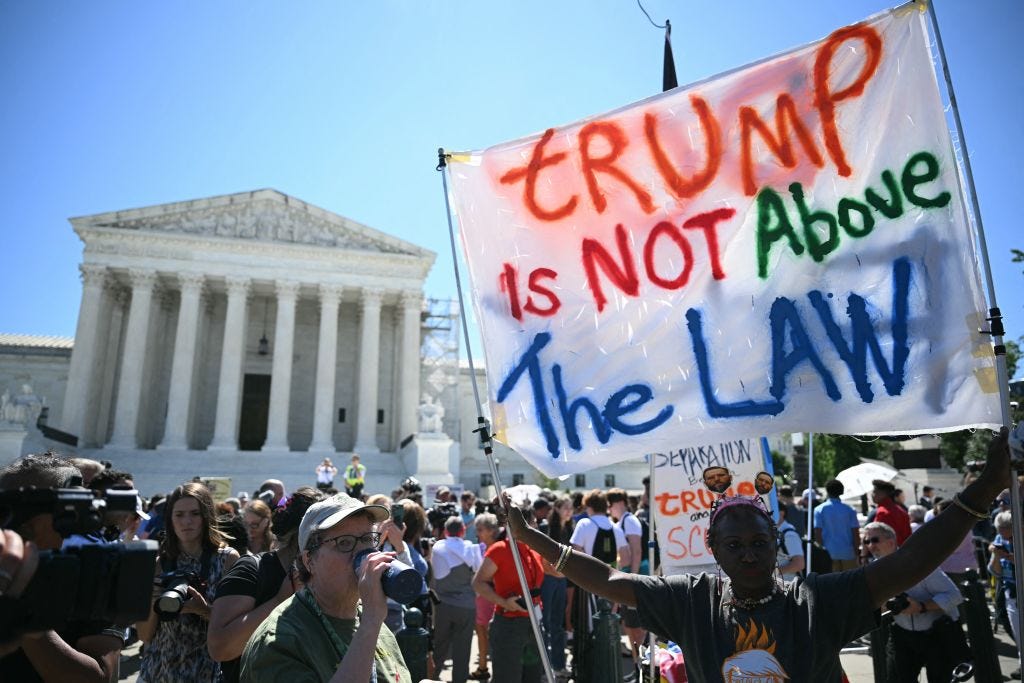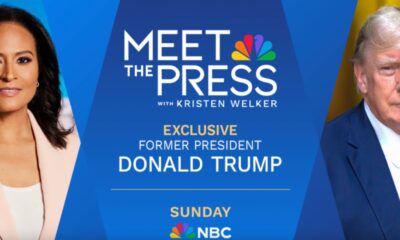Substacks
Diane von Furstenberg Is More Than a Girlboss Suzy Weiss

This piece was first published in our news digest, The Front Page. To get our latest scoops, investigations, and columns in your inbox every morning, Monday through Thursday, become a Free Press subscriber today:
The new Diane von Furstenberg documentary, Diane von Furstenberg: Woman in Charge frames the 77-year-old Belgian designer as the world’s first girlboss: an entrepreneur unafraid to be sexy as she kicked down the doors of the boys’ club in her stilettos.
But while she is, yes, wildly successful and self-possessed, her animating principle isn’t progressivism or gender equality but an endless quest for freedom.
Von Furstenberg sought sexual freedom since she went to boarding school, falling in love with a man and then a woman in quick succession, and then, as she got older, everyone else. She said of leaving Prince Egon von Furstenberg, her first husband with whom she had two kids, “Divorce was freedom.” She described her iconic wrap dress, a form-fitting, printed jersey blockbuster as the “uniform for freedom.” She says of the crowd at Studio 54, “We thought we had invented freedom.”
She even chafes at the title of fashion designer, saying instead, “I had a vocation to be a free woman.”
Von Furstenberg’s obsession with being free is all downstream of the fact that her mother Lily was a prisoner of the Nazis, weighing 49 pounds when she was liberated from Auschwitz. Doctors told Lily it would be impossible to have a child. Soon after, Diane was born in Brussels, with a mission, it seems, to push liberation as far as she could.
Another wrinkle in the plot to make von Furstenberg into a boss babe fighting the patriarchy: she refuses to be a victim.
The director asks if any men made her feel uncomfortable early in her career. “I would never give anyone that much credit,” she says. A New Yorker reporter said that von Furstenberg “didn’t fit the mold” of a second-wave feminist because she “wore fishnet stockings and heels.” He asked von Furstenberg if she felt accepted by that movement, to which she offered, “I don’t know. I never asked them.” He then brings up sex positivity, to which von Furstenberg replies, “What did you say? ‘Sex-positive’? What does that mean?”
And unlike the girlboss of the 2010s, von Furstenberg doesn’t care how her image—which is of a rich, bisexual vixen—is received, or how her politics come off, or what it says about her that she married two fabulously wealthy men (her second husband is Barry Diller) who, we’re meant to understand, are both gay. It didn’t matter, and in the documentary, you see that she loves them both. Fidelity, domesticity, or stability were not the point of her marriages—freedom was—and they both offered her that.
There are drawbacks, though, to being this free. Her daughter describes being neglected while her mother went out on the town every night. She seems alienated from her own feelings, never crying in the movie and remarking flatly while looking at a cattle car, the same kind that would’ve shipped her mother to a concentration camp, “Crazy, huh?” She says she’s not afraid to die, even though she thinks about it “all the time.”
Most of us will never be as free as Diane von Furstenberg, and plenty of us don’t even want that level of freedom. She went the whole way with it, accepting that being free and doing what you want ups the risk of being burned, exposed, and judged. Like that perfect dress, she wears it with pride.
Suzy Weiss is a reporter at The Free Press. Read her piece, “Hurkle-Durkle Is the New Way to Self-Care Ourselves to Death,” and follow her on X @SnoozyWeiss.
Substacks
The Takeaways from Three Supreme Court Rulings Jed Rubenfeld

Yesterday the Supreme Court published its decision in the Trump immunity case. Depending on who you believe, it was either a righteous victory for the former president—or the beginning of the end of democracy as we know it.
This politically high-stakes ruling was just one of a series of important judgments decided by the court at the end of a busy term. And reader, a confession: we’ve been too preoccupied by all the debate fallout to properly chew through it all. And so, in search of some much-needed clarity, we dropped Jed Rubenfeld a line. Jed is a professor of constitutional law at Yale Law School and, whether in the classroom or on his YouTube show Straight Down the Middle, he demonstrates his knack for stripping away the hyperbole that accompanies so much legal commentary these days. In other words, he explains complicated legal cases in a way that the layman can understand. So here’s Jed, explaining the Trump immunity and two other important rulings.
The Presidential Immunity Case
Should a former president be immune from prosecution after leaving office? Believe it or not, we had no law on that issue for two hundred years. There didn’t need to be any: until now, no former president had ever been criminally prosecuted for actions taken during his presidency. But Trump is being prosecuted for (among other things) his involvement in January 6, so the immunity issue had to be confronted.
Trump’s lawyers argued for complete immunity. The special prosecutor, Jack Smith, argued for zero immunity, and the D.C. Circuit basically adopted the prosecution’s position. The Supreme Court rejected both extremes, laying down a new test for presidential immunity and giving something to both sides.
At its most simple, the Court’s new test first asks whether the conduct in question was an “official” act—i.e., an exercise of the president’s powers. If it was not an official act, then there’s no immunity at all. If it was official, the next question is whether the president was exercising a “core” constitutional power. If so, then there’s complete immunity—no prosecution is permissible. But if we’re dealing with an official act outside the core, then “presumptive” immunity applies—the president will be presumed immune unless the prosecution can rebut that presumption. What does that mean? Well, no one knows exactly, because it’s new law.
It will now be up to the lower courts to apply those standards. The practical upshot: contrary to the prosecution’s hopes, there’s no way this case can be tried before the election. With more appeals likely, applying the Court’s new tests to the various allegations against Trump could take years.
The Chevron Case
You’ve read by now that the Court overruled Chevron, but you probably have no idea what that means. Here’s the story.
Administrative agencies do the bulk of federal lawmaking. Is that constitutional? Yes, said the Court eighty years ago. Congress can delegate legislative powers to agencies, and agencies can make law as long as they stay in their lane—i.e., within the scope of the powers Congress gave them.
But who decides if agencies are staying in their lane? Who gets to interpret the statutes that give the agencies their power? You might think statutory interpretation is a judicial prerogative. But no. The agencies get to interpret their own statutes, said the Court in the famous 1984 Chevron case.
Not anymore. In the just-decided Loper Bright case, the High Court overturned Chevron, telling lower courts that it’s up to them to interpret the relevant statutes. Critics make two points. First, competence. As Justice Kagan asked in her dissent, how is a court supposed to decide when an alpha amino acid polymer qualifies as a “protein” under the food and drug statutes? With Chevron gone, courts may find themselves struggling with questions they can barely understand.
But the deeper question is about power. According to Justice Kagan, the majority’s decision is a “grasp for power”—with the justices getting the last word on more and more issues. That’s the second big critique, but it may be overstated. Read carefully, the majority opinion in Loper Bright gives Congress—not the courts—the last word. If Congress wants agencies to have the interpretive power, and require courts to defer to agency interpretations, Congress just has to say so.
Bottom line: Loper Bright might not be as big a deal as some say. The Chevron doctrine was already full of holes. Loper Bright may ultimately be seen less as a judicial power grab and more as part of a line of recent Supreme Court decisions reimposing needed checks and balances on federal agencies.
The Social Media Censorship Case
In a case originally called Missouri v. Biden, a federal district court enjoined the Biden administration’s years-long, multiagency campaign to get social media platforms to censor disfavored content, calling that campaign “arguably the most massive attack on the freedom of speech in United States history.” But the Supreme Court reversed that injunction in the just-decided Murthy v. Missouri.
Full disclosure: I’m a lawyer in many cases challenging social media censorship, including a case connected to Murthy in the lower courts. So for me, the Supreme Court’s decision is disappointing. I view government involvement in social media censorship as a major First Amendment problem, especially when the speech being blocked or shadowbanned is factually accurate or political opinion, like the Hunter Biden laptop story, which was suppressed by all the major platforms in the run-up to the 2020 election.
But here’s what you need to know. Murthy did not reach the merits. It reversed solely on the basis of lack of standing. According to the Court, the plaintiffs hadn’t shown that the government had specifically targeted them for censorship and even worse, the plaintiffs had shown only that they’d been censored in the past. That wasn’t enough, said the Court, to establish standing for an injunction.
Because the Murthy decision is based on standing, the fight is far from over. Murthy leaves the door open for other plaintiffs, with firmer standing, to bring essentially the same claims. For more details on this, see my Murthy episode on Straight Down the Middle:
One more thing on Murthy. . . Free Press contributor Jay Bhattacharya was one of the plaintiffs in the case. He wrote about it for us when they won in a lower court last year. We asked him what he made of the Supreme Court’s decision.
He told us that he was as optimistic about their chances in a fresh case in a lower court, but said that “our loss in the Supreme Court points to the need for Congress and voters to act to protect American free speech rights now that it is clear that the Supreme Court will not do so. Congress should pass a law prohibiting the executive branch and associated federal bureaucracies from censoring Americans via direct and indirect pressure on social media.”
He added that “In a sense, by exposing and publicizing the government’s censorship operation, which cannot survive in the sunlight, we have already won despite the disappointing result in the Supreme Court.”
Jed Rubenfeld is professor of constitutional law at Yale Law School.
Become a Free Press subscriber today:
Substacks
Niall Ferguson: The Democratic Party Awaits Its Gorbachev Niall Ferguson

The most impressive feature of Thursday’s debate between Brezhnev and Andropov—sorry, Trump and Biden—is that anyone watching was in the least surprised by what it revealed.
The president is senile. The former president is a blowhard. Both these truths have been obvious for years. Yet somehow The New York Times editorial board, the hosts of Pod Save America, and numerous other eminent liberal authorities were shocked by what CNN broadcast from Atlanta.
It all put me in mind of Donald Rumsfeld’s typology of knowledge from back in 2002. “As we know,” he told journalists at a briefing about the alleged ties between Saddam Hussein and al-Qaeda, “there are known knowns; there are things we know we know. We also know there are known unknowns; that is to say we know there are some things we do not know. But there are also unknown unknowns—the ones we don’t know we don’t know. And if one looks throughout the history of our country and other free countries, it is the latter category that tends to be the difficult ones.”
This framework can be traced back to a 1955 paper by the psychologists Joseph Luft and Harrington Ingham. Rumsfeld himself attributed it to NASA administrator William Graham, with whom he had worked in the 1990s on the congressional Commission to Assess the Ballistic Missile Threat to the United States.
But the category Rumsfeld omitted—the one I’ve been thinking of since Thursday—is the category of “unknown knowns.” These are perfectly obvious dangers that decision-makers unconsciously or willfully ignore because they do not accord with their preconceptions.
Last year we saw another striking example of an unknown known. After the pogrom carried out by Hamas against Israel on October 7, 2023, elite university campuses erupted with protests that in many cases were pro-Hamas or overtly antisemitic. Some of the world’s most brilliant investors were shocked to discover that the elite colleges they have been supporting with their hundreds of millions of dollars have enrolled or employed a substantial number of leftists whose “progressive” views include variants of antisemitism.
But this has been clear to anyone who bothered to visit the Harvard or Yale campus over the last decade.
The question is: Are we dealing here with genuine myopia? Or are the people professing to be shocked by Harvard antisemitism or Biden’s senility more like Captain Renault in Casablanca, who professes to be “shocked, shocked” that people are gambling at Rick’s nightclub, even as he pockets his winnings? The answer is that they are much closer to Captain Renault than they would care to admit to themselves because, like him, they belong to a thoroughly corrupt political system.
People love to ask: “Are these really the best candidates we can come up with?” What they mean is: “Why has the American political system provided voters with this terrible choice between two embarrassing old men for the post of president?”
It is a hard question to answer if you refuse to accept that our system today evinces similar symptoms to that of other degenerating polities, notably the Soviet Union in the 1980s. (There are other examples. The last communist leaders of Bulgaria, Czechoslovakia, East Germany, Hungary, and Romania were all in their seventies.)
Since my latest column in these pages—which made the argument that we’ve recently become more like the Soviets than we want to face—there have been dissenting opinions, from Jonah Goldberg and Noah Smith, among others. However, as Ross Douthat acknowledged, one undeniable common factor is a leadership selection process that produces embarrassing old men.
There are five structural reasons for American political senescence.
Substacks
June 30, 2024 Heather Cox Richardson
-

 Awakening Video10 months ago
Awakening Video10 months agoThis is What Happens When You Try to Report Dirty Cops
-

 Substacks3 months ago
Substacks3 months agoTHE IRON-CLAD PIÑATA Seymour Hersh
-

 Substacks9 months ago
Substacks9 months agoThe Russell Brand Rorschach Test Kathleen Stock
-

 Substacks10 months ago
Substacks10 months agoA real fact-check of Trump’s appearance on Meet the Press Judd Legum
-

 Substacks8 months ago
Substacks8 months agoLetter to the Children of Gaza – Read by Eunice Wong Chris Hedges








